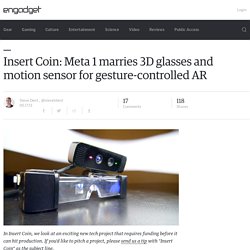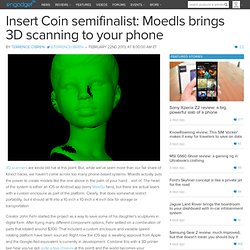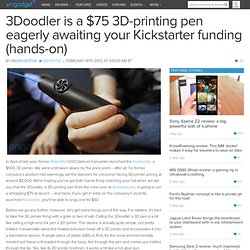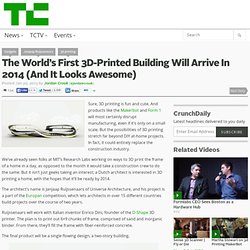

Leap Motion's latest motion tracking tech can see your joints. 3D Systems announces Sculpt, software that makes your 3D-printed dreams a reality (video) There's been a fundamental disconnect for as long as desktop 3D printers have been an affordable reality: how can consumers easily create 3D models to be printed?

At the moment, the best solutions for finding objects to 3D print are databases like Thingiverse -- places where you can search for and download files that most closely match what you're looking to create. The shortcoming with such systems is clear: what happens when no one's taken the time to create the files you want? Two other, more customizable solutions are steadily becoming a reality for home users. The first is 3D scanning, as typified by products like Microsoft's next-gen Kinect and MakerBot's prototypical, lazy Susan-esque Digitizer.
Even once these become more mainstream products, however, they'll no doubt continue to have their shortcomings. Sculpt really is an apt name here. The applications are a lot more compelling, however, when it comes to things like mashups. Show full PR text Comments.
Meta. Meta Wants to Become the Next Augmented-Reality Glasses Phenom - Liz Gannes - Product News. Insert Coin: Meta 1 marries 3D glasses and motion sensor for gesture-controlled AR. In Insert Coin, we look at an exciting new tech project that requires funding before it can hit production.

If you'd like to pitch a project, please send us a tip with "Insert Coin" as the subject line. Now that Google Glass and Oculus Rift have entered the zeitgeist, might we start to see VR and AR products popping up on every street corner? Perhaps, but Meta has just launched an interesting take on the concept by marrying see-through, stereoscopic, display glasses with a Kinect-style depth sensor.
That opens up the possibility of putting virtual objects into the real world, letting you "pick up" a computer-generated 3D architectural model and spin it around in your hand, for instance, or gesture to control a virtual display appearing on an actual wall. Apps can be created via Unity3D and an included SDK on Windows computers (other platforms will arrive later, according to the team), with developers able to publish their apps on the upcoming Meta Store. Hands-on with Meta 1, a 3D augmented reality headset with a natural UI (video)
Like Atheer Labs, Meta is aiming to create an AR system that provides users with a natural interface.

That means you can reach out and interact with three dimensional graphical objects, as opposed to using just gestures and voice to navigate the OS. We demoed Meta-1, and found it a similar experience to our time with Atheer's prototype device. Grabbing objects by making a fist and moving them around in space is an interesting computing experience, but the accuracy of the system is far from ideal. We found it difficult to tell how far we needed to extend our hand to interact with an object at times, and the functionality at this point is rudimentary. Of course, the SDK isn't finished yet, and the UI is still in its infancy. Company founder Meron Gribetz informed us that he has been working to find the right UI paradigm for AR for over two years now.
Insert Coin semifinalist: Moedls brings 3D scanning to your phone. 3D scanners are kinda old hat at this point.

But, while we've seen more than our fair share of Kinect hacks, we haven't come across too many phone-based systems. Moedls actually puts the power to create models like the one above in the palm of your hand... sort of. The heart of the system is either an iOS or Android app (sorry MeeGo fans), but there are actual lasers with a custom enclosure as part of the platform. Consumer 3D Printing; Manufacturing’s Big Bang? - Out of the Toy Box.
As many of you know, I am fascinated by the prospect of in home 3D printing and what it could mean for the toy industry.

No longer would you have to make an action figure in China, put it on a container ship, ship it to the US, transship it to a warehouse, ship it again to a retail outlet and hope a consumer finds and buys it. Instead, you would be able to sell a download right to a consumer who would in turn print it out in the comfort of his or her own bed or living room. It would be our industry's version of the iPod or Netflix. 3Doodler is a $75 3D-printing pen eagerly awaiting your Kickstarter funding (hands-on) In April of last year, former MakerBot COO Samuel Cervantes launched the Solidoodle, a $500 3D printer.

We were a bit taken aback by the price point -- after all, his former company's product had seemingly set the standard for consumer-facing 3D-printer pricing at around $2,000. We're hoping you've got both hands firmly clutching your hat when we tell you that the 3Doodler, a 3D-printing pen from the crew over at Wobbleworks, is going to run a whopping $75 at launch -- and heck, if you get in early on the company's recently launched Kickstarter, you'll be able to snag one for $50. Before we go any further, however, let's get some things out of the way. 3D printing. The World’s First 3D-Printed Building Will Arrive In 2014 (And It Looks Awesome) Sure, 3D printing is fun and cute.

And products like the Makerbot and Form 1 will most certainly disrupt manufacturing, even if it’s only on a small scale. But the possibilities of 3D printing stretch far beyond DIY at-home projects. In fact, it could entirely replace the construction industry. We’ve already seen folks at MIT’s Research Labs working on ways to 3D print the frame of a home in a day, as opposed to the month it would take a construction crew to do the same. But it isn’t just geeks taking an interest; a Dutch architect is interested in 3D printing a home, with the hopes that it’ll be ready by 2014. The architect’s name is Janjaap Ruijssenaars of Universe Architecture, and his project is a part of the Europan competition, which lets architects in over 15 different countries build projects over the course of two years.
Ruijssenaars will work with Italian inventor Enrico Dini, founder of the D-Shape 3D printer. Here’s the project in Ruijssenaars’ words: [via 3ders.org]